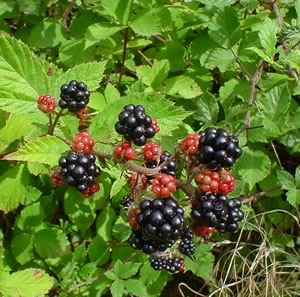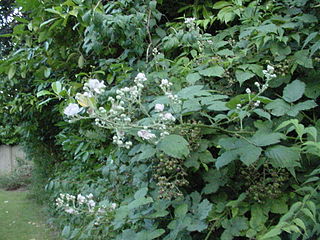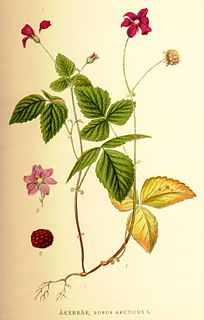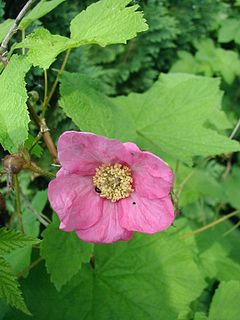
Rubus is a large and diverse genus of flowering plants in the rose family, Rosaceae, subfamily Rosoideae, with over 1,350 species.

A bramble is any rough, tangled, prickly shrub, usually in the genus Rubus, which grows blackberries, raspberries, or dewberries. "Bramble" is also used to describe other prickly shrubs such as roses. The fruits include blackberries, arctic brambleberries or raspberries depending on the species and are used to make jellies, jams and preserves.

Rubus spectabilis, the salmonberry, is a species of bramble in the rose family Rosaceae, native to the west coast of North America from west central Alaska to California, inland as far as Idaho. Like many other species in the genus Rubus, the salmonberry plant bears edible fruit, typically yellow-orange or red in color, resembling raspberries in appearance.

Rubus phoenicolasius is an Asian species of raspberry in the rose family, native to China, Japan, and Korea.

Rubus caesius is a Eurasian species of dewberry, known as the European dewberry. Like other dewberries, it is a species of flowering plant in the rose family, related to the blackberry. It is widely distributed across much of Europe and Asia from Ireland and Portugal as far east as Xinjiang Province in western China. It has also become sparingly naturalized in scattered locations in Argentina, Canada, and the United States.

Rubus parviflorus, commonly called thimbleberry, is a species of Rubus native to northern temperate regions of North America. It bears edible red fruit similar in appearance to a raspberry, but shorter, almost hemispherical. Because the fruit does not hold together well, it has not been commercially developed for the retail berry market, but is cultivated for landscapes. The plant has large hairy leaves and no thorns.

Rubus arcticus, the Arctic bramble or Arctic raspberry, is a species of slow-growing bramble belonging to the rose family, found in arctic and alpine regions in the Northern Hemisphere.

Rubus odoratus, the purple-flowered raspberry, flowering raspberry, or Virginia raspberry, is a species of Rubus, native to eastern North America, from Nova Scotia west to Ontario and Wisconsin, and south along the Appalachian Mountains as far as Georgia and Alabama.

Rubus leucodermis, also called whitebark raspberry, blackcap raspberry or blue raspberry, is a species of Rubus native to western North America, from Alaska south as far as California, Arizona, New Mexico, and Chihuahua.

Rubus niveus is a species of Rubus native to southern Asia, from Afghanistan east through India and China to Taiwan and the Philippines, south to Sri Lanka and Malaysia, and north to Gansu in China.

Physocarpus opulifolius, known as common ninebark, Eastern ninebark, Atlantic ninebark, or simply ninebark, is a species of flowering plant in the rose family Rosaceae, native to eastern North America.

Sambucus racemosa is a species of elderberry known by the common names red elderberry and red-berried elder.

Rubus rosifolius,, also known as roseleaf bramble, Mauritius raspberry, thimbleberry,Vanuatu raspberry and bramble of the Cape is a prickly subshrub native to rainforest and tall open forest of the Himalayas, East Asia, and eastern Australia.

Rubus parvifolius, called Japanese bramble, or Australian raspberry in the United States or native raspberry in Australia is a species of plant in the rose family. It is a scrambling shrub native to eastern Asia and Australia. It has also become naturalized in a few scattered locations in the United States.

Rubus nivalis, commonly known as snow raspberry, is a species of flowering plant in the rose family. It is native to northwestern North America: British Columbia, Washington, Idaho, and far northern California.

Rubus pubescens is a herbaceous perennial widespread across much of Canada and the northern United States, from Alaska to Newfoundland, south as far as Oregon, Colorado, and West Virginia.

Rubus pedatus is an Asian and North American species of raspberry known under the common names five-leaved bramble, strawberryleaf raspberry and creeping raspberry.

Rubus allegheniensis is a species of bramble, known as Allegheny blackberry and simply as common blackberry. Like other blackberries, it is a species of flowering plant in the rose family. It is very common in eastern and central North America. It is also naturalized in a few locations in California and British Columbia.
Rubus aboriginum is a North American species of dewberry, known as the garden dewberry and aboriginal dewberry. Like other dewberries, it is a species of flowering plant in the rose family, related to the blackberry. It is native to the United States and Mexico, primarily in the southern Great Plains with additional populations scattered in the eastern United States and in Nuevo León.

Rubus tricolor is an evergreen prostrate shrub, native to southwestern China. Leaves are dark green above, pale green below, and stems have red bristles. It has white flowers in summer, and edible red fruit. It grows approximately 0.3 m (1 ft) high and usually forming a vigorously spreading, dense mat. In cultivation it is mainly used as groundcover. Common names include Chinese bramble, groundcover bramble, creeping bramble, Korean raspberry, Himalayan bramble, Groundcover Raspberry. In Chinese it is called 三色莓.




















